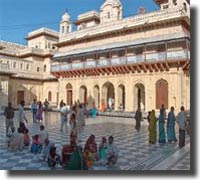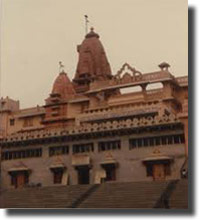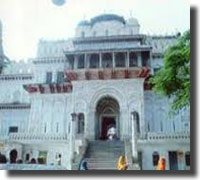Location :
Ayodhya, a very holy city located in Uttar Pradesh is an important pilgrimage site. Lord Rama was born and has spent many of his pastimes here. The city is said to have once had a perimeter of 96 miles and was the capital of Koshala thousands of years ago. It is located on the banks of the Gogra (Ghaghara or Saryu) River, bathing in this river is supposed to destory even the sin of killing a Brahmin. On the right bank of this river Ghagra or Saryu, as it is called within sacred precincts, stands the holy city of Ayodhya, believed to be the birth place of lord Rama, who is the seventh incarnation of lord Vishnu.
Significance of the Temple
Ayodhya is predominantly a city of temples yet; all the places of worship are here, including the Hindu religion. Remnants of Hinduism, Buddhism, Jainism and Islam can still be found in Ayodhya. Ayodhya has been most sacred while being an important religious center of Uttar Pradesh.
Ayodhya city is believed to in existence before the start of human race on earth. The city has been the capital of Lord Rama's kingdom.When Gods were present on earth, Ayodhya was the centre of their activities. Lord Rama, the legendary god's birth took place here and was brought up here and later ruled the kingdom from Ayodhya.

Janmabhoomi
Ayodhya during ancient times was known as Kosaldesa. The Atharvaveda describes it as "a city built by gods and being as prosperous as paradise itself". The illustrious and famous Ikshvaku of the solar clan (suryavamsa) was the ruling dynasty of this region.
Rama Janma Bhoomi is where Lord Rama is been believed to have taken birth. There is a small Lord Rama temple here in the location. Previously there used to be the Babri Mosque, which was constructed in the 15th century by the Moghuls. Later in 1992 the mosque was destroyed, and at the present time there are plans to build a grand Rama Temple here.
Guptar Ghat
Ayodhya is predominantly a city of temples yet; all the places of worship are here, including the Hindu religion. Remnants of Hinduism, Buddhism, Jainism and Islam can still be found in Ayodhya. Ayodhya has been most sacred while being an important religious center of Uttar Pradesh. Ayodhya city is believed to in existence before the start of human race on earth. The city has been the capital of Lord Rama's kingdom. When Gods were present on earth, Ayodhya was the centre of their activities. Lord Rama, the legendary god's birth took place here and was brought up here and later ruled the kingdom from Ayodhya. The word Ayodhya clearly means "which can't be defeated". There are many temples in this small town. The temples are mostly dedicated to lord Rama and his family and friends.
In Guptar Ghat there are a bunch of nice temples and nearby it has a nice park. Gupta is defined as disappearance. This is the place where Rama left His body . There exist few nice temples here, one called Chakra Harji Vishnu, Gupta Harji, and other called Raja Mandir. There are many Deities in the Chakra Harji Vishnu Temple, including what appears to be a very old carved Chakra Harji Vishnu Deity. There is also an imprint of Sri Rama's feet here. In 19th century King Dasrath Singh build a temple and small palace here.
Ramkot

The Hanuman Garhi
Hanuman Garhi is situated in the centre of the town, this temple can be reached by a flight of 76 steps. Legend conveys that Lord Hanuman lived here, in a cave and was guarding the Janmabhoomi or Ramkot. The main part of Hanuman Garhi temple contains the statue of Anjani, with child Hanuman, seated on her lap. The devotees visiting this temple believe that all their wishes will be granted with a visit to this holy shrine. The temple has the massive structure in the shape of a four-sided fort with circular bastions at each corner, houses a temple of Hanuman and is the most popular shrine in Ayodhya.
Treta-Ke-Thakur
This particular temple of Treta -ke- Thakur stands at the place, where Rama is said to have performed the Ashvamedha Yagya. Ashwamedha Yagna was the ritual done, where by horses were left to roam in the country. The places where horses these would go, would come under the reign of the Yagna performer.
About 300 years ago the Raja of Kullu is the one who built a new temple here, which was improved by Ahilyabai Holkar of Indore, during the period of 1784. At the same time, the other adjoining ghats were also built. The initial idols in black sandstone were recovered from Saryu and placed in the new temple, now famous as Kaleram-ka-Mandir.
Nageshwarnath Temple

Other Places to Visit
Other places one can visit in Ayodhya are the river surrounding Lakshman Ghat. Lakshman, who was the brother of Rama, is said to have bathed at Lakshman Ghat. There is also a Vasistha Kund temple which is a small round kund like a well. There are Sita-Rama Deities in this temple. Kaushalya, the mother of Rama, is said to have established the Kshireswara Nath Temple for Sita. Bharata Kund, at Nandigram, 20 km from Ayodhya, is said to be the place where Bharata ruled while Rama was in exile for 14 years. A half km north of Janmabhoomi is Swarga Dwara, or Ram Ghat, which is an important bathing ghat.
Time to Visit
Though the weather of Ayodhya is generally mild with hot spells in summer (April-June), it is advisable to travel here in the winter months. Ayodhya can be visited any time of the year. However, winters here can be quite cold. It is suggested that one visits Ayodhya on the auspicious day of Ramnavami, the day of Lord Rama's birth, an occasion which is celebrated with great pomp and show. Ramnavami usually comes in the Hindu month of Chaitra (March-April).
Accommodation Facilities at the Temple
|
Hotels, inspection bungalows, private cottages, etc. are available to suit all budgets. The region around the Ayodhya abounds in family holiday resorts and cottages. One can obtain excellent discounts on accommodation via temple pilgrimage tours and temple tours.
|
Nearby tourist places to Ananta Vasudeva Temple Agra Allahabad Ayodhya Kanpur Lucknow Varnasi |  |
How to reach the Temple
- Throuh Air for reaching Ayodhya the holy city, the nearest airports are Amausi, Bumrauli and Babatpur. The Amausi airport, located at a distance of 134 kms is the most nearest airport. Flights to/from most major Indian cities such as Delhi, Mumbai and Bangalore are rather frequent.
- Ayodhya is situated on the broad gauge northern railway line on Mughal Sarai- Lucknow main route. Ajodhya/Faizabad are connected to various parts of the country by rail lines.
- Ayodhya is well connected with other places by road, as it is located on the main highway, which runs through the town on the way from Faizabad to Gorakhpur. There are always frequent tempos and buses shuttling along the highway from Faizabad to Ayodhya.
- Through Railways- Ayodhya doesn't have a railway station and one can catch trains from Faizabad. Lucknow, Allahabad and Gorakhpur are connected by rail with Faizabad.



